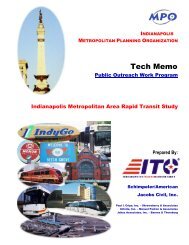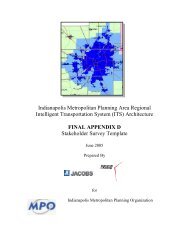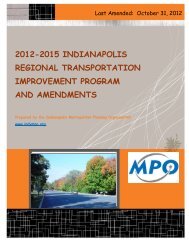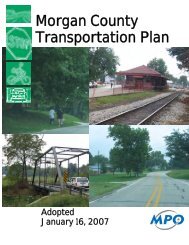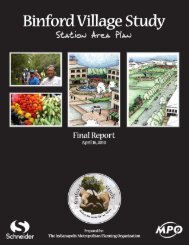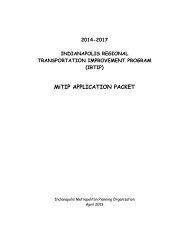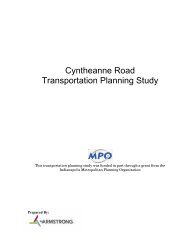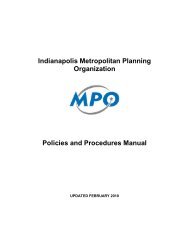Minutes - Indianapolis Metropolitan Planning Organization
Minutes - Indianapolis Metropolitan Planning Organization
Minutes - Indianapolis Metropolitan Planning Organization
You also want an ePaper? Increase the reach of your titles
YUMPU automatically turns print PDFs into web optimized ePapers that Google loves.
<strong>Indianapolis</strong> Regional Transportation Council<br />
<strong>Organization</strong>al Structure Study Committee Meeting <strong>Minutes</strong><br />
July 12, 2013; 9:00 am<br />
<strong>Metropolitan</strong> <strong>Indianapolis</strong> Board of Realtors<br />
1912 N. Meridian St., <strong>Indianapolis</strong><br />
Committee Members Present (voluntary; open to all interested IRTC Tech and Policy members)<br />
Mike Terry, IndyGo<br />
Samantha Cross, IndyGo<br />
Karla Vincent, Greenfield<br />
Brad Davis, Hamilton County<br />
Devin Stettler, United Consulting (Hancock Co.)<br />
Deb Luzier, Whitestown<br />
Mark Richards, Greenwood<br />
Mark Myers, Greenwood<br />
Others Present<br />
Anna Tyszkiewicz, MPO<br />
Stephanie Belch, MPO<br />
Jerry Bridges, Madison Co. Council of Gov’ts<br />
Chad Lance, Whitestown<br />
Randy Walter, INDOT<br />
1. WELCOME & INTRODUCTIONS<br />
Larry Jones, <strong>Indianapolis</strong><br />
Rich Carlucci, Plainfield<br />
John Beery, Noblesville<br />
Ehren Bingaman, CIRTA<br />
Bruce Northern, Lawrence<br />
Christine Altman, Hamilton County<br />
Larry Heil, FHWA<br />
Sean Northup, MPO<br />
Steve Cunningham, MPO<br />
Ryan Wilhite, MPO<br />
Austin Gibble, CIRTA intern<br />
Anna Tyszkiewicz welcomed the attendees to the fourth meeting of the IRTC <strong>Organization</strong>al Study Committee,<br />
and then turned it over to Ryan Wilhite for the results of the IRTC Surveys and Interviews.<br />
2. SURVEY AND INTERVIEW FINDINGS<br />
Survey Results<br />
Ryan Wilhite presented the results of the on line survey. Three of the things that the responses indicated:<br />
<br />
<br />
<br />
MPO 101 Education Needed for IRTC Members<br />
o Explaining the Function of the MPO, the Federal-aid Process, and the <strong>Metropolitan</strong> <strong>Planning</strong> Process<br />
MPO Staff communicates well with the LPAs and Partners, especially via e-mail and phone, and at IRTC meetings.<br />
Mixed Results on MPO bias toward <strong>Indianapolis</strong>:<br />
o There is split sentiment on whether the MPO’s structure is biased towards one jurisdiction; and narrative<br />
comments indicated jurisdictions other than <strong>Indianapolis</strong>.<br />
o Project selection is unbiased in general.<br />
o Neutral on staff being influenced by the current structure.<br />
Interview Findings<br />
In addition to the online survey to obtain IRTC member feedback, Ryan and Stephanie Belch conducted inperson<br />
interviews with a sampling of member jurisdictions. Prepared questions, along with follow-up questions,<br />
were asked of 14 member jurisdictions and 5 partner agencies (both policy and technical representatives). In<br />
addition, informal interviews were conducted with current and former MPO staff, and the Anderson and<br />
Columbus MPO directors.<br />
Regarding the responses to the question of <strong>Indianapolis</strong> influencing the metropolitan planning process, what we<br />
found was that a majority of those interviewed indicated that <strong>Indianapolis</strong> does influence MPO staff but not to a<br />
fault. Factors that shape this influence are population (<strong>Indianapolis</strong> is largest public agency), land area,<br />
infrastructure age, location of MPO in City-County Building, and hiring/firing decisions. There was also<br />
Page 1 of 7
perceived influence on specific projects (Georgia Street Super Bowl Improvements, transit/Indy Connect, and<br />
96 th St. at Keystone project).<br />
In addition to the City of <strong>Indianapolis</strong> influence, a few responses indicated that other jurisdictions, including<br />
their own, also influence the MPO. An LPA’s staff capacity, knowledge, and experience with the process can<br />
also carry influence. As well, the characteristics of the LPA’s representative carries influence – is that person<br />
knowledgeable of and experienced in the federal-aid process? Is that person outspoken at IRTC meetings?<br />
One thing that was clear from all interviews is that most members feel the project selection process is<br />
transparent. This idea is also supported by the survey results. We have a data-driven project selection process<br />
that may need some tweaks or modifications, as brought up in interviews. Improving the scoring process is<br />
something that everyone agrees MPO staff strives for.<br />
Other responses in the interviews indicated that most feel the MPO provides value for its jurisdiction. The MPO<br />
could, however, provide more value by spending more time educating members. This idea of an MPO 101 was<br />
brought up in the surveys and in almost every interview, so education is critical. Members do feel comfortable<br />
speaking/asking questions at meetings – but only after they understand the process - which can take several<br />
years! Understanding the process is key to engagement. Many members stated that “You get out of it what you<br />
put into it.”<br />
Some other common responses indicate that MPO staff communication and response is excellent; IRTC<br />
quarterly meetings provide updates on projects, networking opportunities for members, and contact with MPO<br />
staff.<br />
When asked about a regional land use forum, many members indicated an interest. Many also indicated an<br />
interest in water and thoroughfare planning forums.<br />
In summarizing the interviews, the key findings are:<br />
<br />
<br />
<br />
Some members felt that the city of <strong>Indianapolis</strong>’ influence of the MPO is subtle – location in the city-county<br />
building, HR, perception of influence on specific projects.<br />
But, when it comes to money being distributed, members feel that the project selection process is<br />
transparent.<br />
Another key finding was that a regional ethos seems to be missing.<br />
Some of the interviews brought out a focus on the local jurisdiction – a problem common to all MPOs. It’s<br />
something that is not the fault of local jurisdictions – IRTC members are elected or staff of local<br />
governments. But for the MPO, it’s our task to think regionally, and it’s our task to educate members. This<br />
will be something the MPO can work on.<br />
Larry Heil asked if the jurisdictions had specific recommendations. Ryan responded that what we’re reporting<br />
today are trends, but we will be looking at individual responses for ways to improve the process. And, how we<br />
can incorporate everything in the organizational study outcomes. We already know that an “MPO 101”<br />
education effort will be a recommendation. Education of the transportation planning process is a need that we<br />
heard through the responses across the board.<br />
3. MPO FINANCES AND BUDGET PROCESS<br />
Anna Tyszkiewicz took over the presentation to talk about the MPO’s Financial Structure – through the<br />
expenditure of <strong>Metropolitan</strong> <strong>Planning</strong> Funds (PL) that are received from the FHWA and FTA to carry out the<br />
metropolitan planning process.<br />
Page 2 of 7
The MPO uses PL funds to cover annual operating expenses through the UPWP (Unified <strong>Planning</strong> Work<br />
Program). Under MAP-21, PL funds have been reduced; and in Indiana, because the USDOT found Indiana’s<br />
open container law was non-compliant and assessed a $65 million penalty, there’s a further reduction in the<br />
amount of PL funds administered to MPOs in the state.*<br />
*MPO staff has since learned that some or all of the $65 million has been returned to Indiana as HSIP<br />
funding.<br />
Sharing Agreement<br />
Through the INDOT/MPO Sharing Agreement, federal funds are distributed to Indiana via the federal budget<br />
process. The State receives 75% and MPOs receive 25% of all federal funds, balanced between various federal<br />
funding categories. This Sharing Agreement was established through the Indiana MPO Council. Membership in<br />
the MPO Council is comprised of the executive directors of all 14 Indiana MPOs. This is a unique arrangement<br />
in Indiana; there’s no known occurrence elsewhere in the country.<br />
The table below shows the total planning funds each Indiana MPO received for 2013. The allocations include<br />
both FHWA and FTA planning funds.<br />
URBANIZED AREA<br />
Page 3 of 7<br />
2013 PLANNING<br />
ALLOCATION*<br />
ANDERSON $320,490<br />
BLOOMINGTON $255,286<br />
COLUMBUS $193,572<br />
CINCINNATI $7,856<br />
EVANSVILLE $433,819<br />
FORT WAYNE $633,830<br />
KOKOMO $188,858<br />
LAFAYETTE $383,546<br />
LOUISVILLE $304,790<br />
MUNCIE $303,010<br />
NORTHWEST $1,335,547<br />
SOUTH BEND $920,201<br />
TERRE HAUTE $230,986<br />
INDIANAPOLIS $1,981,189<br />
*INCLUDES FTA PLANNING FUNDS<br />
There’s a complicated administrative process for the MPO to receive the planning funds. The Power Point slide<br />
shows the timeline from the federal allocation to UPWP Approval to contract development and invoicing. Anna<br />
pointed out that the City of <strong>Indianapolis</strong> floats the MPO during the first few months of the year as there’s a lag<br />
between contract agreements, invoicing and receipt of payment from INDOT. Typically, according to DMD<br />
Financial Services, this is usually around $1 to $1.5 million each year.<br />
Financial Oversight<br />
In 2009, the MPO transitioned to a pay-to-play process for local match, and also moved-out from under the<br />
Division of <strong>Planning</strong> and is now its own division within the Department of <strong>Metropolitan</strong> Development. Prior to<br />
this transition, the <strong>Metropolitan</strong> Development Commission approved all of the MPO documents (UPWP, IRTIP,<br />
LRTP, etc.), after being approved by the IRTC. Currently, the IRTC approves our UPWP, IRTIP, and LRTP;<br />
while the MDC approves our contracts for PL and other planning funds, and consultant contracts. And, as the<br />
fiduciary agent for <strong>Indianapolis</strong>, the City-County Council approves the MPO budget (but not planning<br />
documents).
The <strong>Indianapolis</strong> Department of <strong>Metropolitan</strong> Development (DMD) organizational chart is shown on the Power<br />
Point slide. Anna reports to the director of the DMD, but is different than the other DMD divisions in that she<br />
does not meet on regular basis with the director as do the other divisions. The MPO does utilize the DMD Public<br />
Information Officer to help with press releases, and to a much greater degree the MPO relies on the Financial<br />
Services section of DMD for grant/contract management.<br />
The fiscal ordinance process is much like a budget amendment. Because we’re on a different grant cycle, we<br />
don’t know what our budget will look like for the following year, and therefore we often have to amend our<br />
budget through the City-County Council after the start of the calendar year, usually during the first quarter. This<br />
usually happens on an annual basis. Christine Altman asked what length of time the fiscal ordinance takes?<br />
Anna responded that ideally it takes 4 to 6 weeks. Christine asked how long it took during the last two years?<br />
Anna explained that this year we received the additional planning grants for the Red and Blue Rapid Transit<br />
Corridors after the 2013 budget was approved in 2012. This fiscal ordinance was introduced in January but was<br />
not passed until April; however, there was no delay in the project and the MPO maintained operations.<br />
Overall Budget 2013<br />
Anna presented the overall budget for 2013 (including PL, CMAQ, and Federal Transit Administration/Federal<br />
Railroad Administration planning grants). Our total federal funding sources are at $1.9M and the local match is<br />
just under $500,000.<br />
The organizational chart for the MPO was shown. Beyond the Executive Director, Assistant Director and Office<br />
Manager, there are 4 staff sections in the MPO. Staff costs equal approximately $1.1 million with $770K for<br />
salaries, $330K in benefits; and $70K to DMD for employees in Division of <strong>Planning</strong>, a legacy contribution<br />
which will be eliminated in 2014.<br />
The $330,000 was further broken down by benefit (health insurance, PERF, Social Security, etc.). Christine<br />
Altman asked if we had the breakdown of percentages for Full Time Equivalent (FTEs) to allow comparison<br />
between LPAs. Some costs are fixed, some fluctuate. Staff will prepare this info for the next meeting. Fixed<br />
costs per employee, and variables (social security, PERF, etc.) like how generous our health plans are; how<br />
healthy our workforce is; health plans, copays, etc.<br />
Overhead costs consist of Information Services Administration (ISA), Financial Services, Building Rent, and<br />
Miscellaneous. Those costs are $153,814; $134,400; $34,000; and $66,220 respectively. Anna explained the<br />
costs associated with ISA; until recently, the costs were not nearly as high. Ryan explained that the amount of<br />
the ISA charge back has increased due in part to a number of factors. ISA had been using reserve funds which<br />
were exhausted about two or three years ago. At that point they adjusted their model to base it more on usage.<br />
The number still seems high, but we won’t know until we do research based on the market. The MPO’s work<br />
requires a huge amount of data, especially the modeling section.<br />
Christine Altman asked what the square footage of the MPO’s office? Ryan responded approximately 1600<br />
square feet. Christine asked if that was enough space? Sean Northup said that it is not enough. But, at this<br />
point in the process, we’re just looking at our current expenses. In the process of the organizational study we<br />
will be looking at our optimum space needs and identifying the gap of where we are today, and where we want<br />
to be in the future.<br />
The group discussed regional GIS data needs and the IMAGIS (<strong>Indianapolis</strong> Mapping and Geographic<br />
Infrastructure System) consortium. Have we isolated these costs? Does it make sense to combine some of these<br />
services on regional basis?<br />
Challenges of <strong>Indianapolis</strong> as host:<br />
• Subject to City’s Pay/Hiring Freezes<br />
o Despite potential ability to raise salaries through PL funding, City policies dictate salary, wage<br />
increases<br />
Page 4 of 7
• Subject to City of <strong>Indianapolis</strong> Human Resources Guidelines<br />
o Residency requirement -- full-time employees must be Marion County residents within 6<br />
months of hiring date<br />
o Since MPO staff are city employees, they are not allowed to be appointed by Mayor to boards<br />
• Limits ability of Executive Director to sit and vote on boards of related interest<br />
• No administrative rights on computers<br />
o<br />
All new software and hardware upgrades must be approved and installed by Information<br />
Services Administration (ISA) staff<br />
• Subject to City of <strong>Indianapolis</strong> budget processes<br />
• Housed in city building<br />
Christine Altman recalled that in the past, when new Mayor came in, the budget was drastically cut by<br />
removing grants that were later reinstated. This happens everywhere; it’s political manipulation. But it is a cost<br />
of being hosted – being subject to administration changes and the changes that brings to city government.<br />
The miscellaneous Overhead Costs were further broken down:<br />
• Travel & Mileage 19%<br />
• Employee Parking and Bus Passes 19%<br />
• Printing and Copying Services 15%<br />
• Supplies 14%<br />
• Memberships 12%<br />
• (to organizations like the National Association of Regional Councils)<br />
• Communication Services 9%<br />
• Motor Pool Charges 9%<br />
• Equipment 3%<br />
Benefits of <strong>Indianapolis</strong> Hosting<br />
<br />
<br />
<br />
<br />
<br />
<br />
<br />
City Float<br />
o Covers operating expenses between start of fiscal year and distribution of reimbursement from INDOT<br />
• 6-8 weeks, $1-1.5 million needed to cover<br />
o When IMAGIS could not cover costs, City paid for IMAGIS until IMAGIS could find the funding<br />
($100k)<br />
Not charged for legal counsel<br />
o DMD pays using other local sources<br />
Human Resources<br />
o Training, other expertise provided as a service<br />
Access to motor pool (especially for traffic count vehicle)<br />
Plotters<br />
o Used to print posters, maps for public meetings or internal use<br />
Wellness Center - Onsite<br />
Copying, printing at reduced cost<br />
Christine asked whether the city or Marion County also pays for IMAGIS or whether the MPO is covering their<br />
portion. Larry Jones believes the city does pay as well. MPO staff will double check the arrangement.<br />
Randy Walter pointed out that the federal cognizant agency is Housing and Urban Development, not U.S.<br />
DOT. This is because the MPO is within the Division of <strong>Metropolitan</strong> Development and HUD is the federal<br />
agency that provides the most grant funding to DMD. The definition of the federal cognizant agency is the<br />
agency that, on behalf of all federal agencies, is responsible for establishing final indirect cost rates and<br />
administering cost accounting standards for all contracts.<br />
Jerry Bridges offered that it took some work to first determine their indirect rate, but once it was established,<br />
it’s not a lot of work. Christine suggested this be added to our list of benefits.<br />
Page 5 of 7
4. DISTRIBUTION OF FUNDING<br />
Steve Cunningham presented the MPO Funding Distribution starting with the Project Selection Process. Each<br />
funding category has its own application process, developed by staff and approved by IRTC. And for some<br />
categories of funds, the MPO does not have control over the project selection (for example Enhancements used<br />
to be selected by a statewide committee). Here are some additional points:<br />
• Projects submitted, scored, and then funded based upon their scoring and available funding<br />
• Processes are implemented and continuously reviewed<br />
• The selection criteria are publicly available on the MPO website<br />
• Federal law prevents the MPO from allocating to jurisdictions based on a percentage or a formula<br />
There are a number of external factors that affect project selection.<br />
• Funding availability<br />
• LPA submitting a project;<br />
• LPA’s familiarity with the funding category scorecard<br />
• LPA’s experience with MPO’s processes<br />
o Specifically, the experience of the technical staff<br />
• Size of LPA staff<br />
o The larger the staff, more capacity to handle more complex project calls<br />
• Complexity of the project<br />
• Complexity of the project call criteria<br />
o The more data, the harder for some of the smaller LPAs<br />
• Involvement of Policy, Technical representatives<br />
• Availability of applicable project to funding call<br />
Steve then passed out “the spreadsheet” which shows the federal funds distributed from 2002 to 2015 by LPA<br />
and the population of those LPAs that are within the <strong>Metropolitan</strong> <strong>Planning</strong> Area (MPA). These population<br />
numbers are the same ones used to calculate the local match dues.<br />
It was suggested that we look at the numbers by county rather than jurisdictions. This means add <strong>Indianapolis</strong> to<br />
Speedway, Lawrence, and Southport for the Marion County number; and add Carmel, Fishers, and Noblesville<br />
to the Hamilton County number; and so on. Staff will complete that task for next meeting.<br />
There was a discussion of which census numbers to use (2000 or 2010).<br />
It’s just a snapshot in time, and only one piece of information.<br />
John Beery suggested that we look at how many projects have been constructed by a jurisdiction. This would<br />
address the problem of projects being awarded, but not managed well and ends up costing more and taking more<br />
time.<br />
Anna responded that we will be starting to track projects better, and that INDOT and FHWA are pushing this.<br />
Our next TIP will include an illustrative list of projects that can be shovel ready – if a project isn’t moving<br />
forward, we’ll have the option to move a project from the illustrative list into the TIP for funding.<br />
In addition, the MPO has formed an Ad Hoc Peer Review committee to make sure all of the MAP-21 funding<br />
we receive is spent by the end of MAP-21 (September 30, 2014). In previous years, INDOT has allowed funding<br />
to continue passed the end of the highway bill.<br />
Obligation authority must be used before August 2014.<br />
Ehren Bingaman asked whether earmarks are included on the spreadsheet? Steve explained that they are not.<br />
Page 6 of 7
MPO staff will add another graph and/or spreadsheet to indicate county totals – and better show how money is<br />
spent regionally and not by LPA. Ryan Wilhite offered that one reason we analyzed by jurisdiction is that in the<br />
interviews, most members were interested in how their jurisdictions compared to others in the MPO in receiving<br />
federal funding, even if they understand that every jurisdiction has different needs and abilities.<br />
These charts and spreadsheets are politically powerful, and so we need to show some different analyses, which<br />
will be addressed at the next meeting.<br />
Larry Heil offered that we could do allocations based on population groups – just as the feds do with Group III<br />
and IV funding pots.<br />
Ryan closed the meeting by going through the next steps:<br />
• Next Meeting Agenda<br />
o Overall Findings, potential by-law changes, potential board structure changes<br />
• Using research gathered to this point, we will present our findings to the committee<br />
with some potential changes based on our observations and member feedback. We do<br />
not anticipate presenting major structural changes at this presentation but to examine<br />
the underlying problems and some resolutions to overcome those challenges.<br />
o Next Meeting Date is August 23rd<br />
o Future Meetings on September 20 th and October 4th<br />
Page 7 of 7



